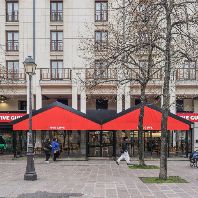Despite the decline in total retail investment transactions in the first half of 2009, retail transactions accounted for 35% of total European real estate investment activity, compared to the last five-year average of 26%, according to the new research from CB Richard Ellis. The sector's share of the H1 European market is the highest proportion on record.
In contrast to recent years, very few large deals took place during the first half of 2009. The average transaction size for the market as a whole fell to 18.4 million in H1 2009, a 59% decline from the 44.4 million average at the peak of the market (H1 2007). At 27 million, the average retail investment transaction size is not markedly different; however, completing larger transactions is proving easier in the retail sector than in other parts of the European investment market. Eight of the top 10 European investment transactions completed in the first half of 2009 were retail. This included Europe's largest transaction so far this year - the sale of the predominantly retail Dawnay Day portfolio in the UK for over £600 million (669 million). The relative strength of the market for large retail lot-sizes has helped to boost the retail sector's share of the overall investment market and, 56% of all deals over 100 million in H1 2009 were in the retail sector.
The restrictive debt market has not yet eased significantly and difficulties in obtaining finance remain in most European markets, therefore impacting the type of retail property being purchased. The reduced number of shopping centre transactions has reflected this landscape, as larger deal sizes are difficult to finance without large equity commitments. Historically, shopping centres have constituted nearly half of total retail investment turnover; but their share fell to only 33% in the first half of 2009. Nevertheless, the evidence suggests that when good quality centres come onto the market, there is generally strong investor demand for them. This was recently demonstrated in the sale of the Plenilunio shopping centre in Madrid, although this was introduced to the market with an assignable finance package.
Despite the generally weaker property investment market in 2009, a number of European countries saw growth in retail investment turnover in H1 compared to the second half of 2008. Italy and France saw the highest growth in activity over that period and accounted for 14% and 11% of the H1 2009 European total respectively. Owner-occupiers have been a significant source of product in both these markets, boosting activity levels, especially in the traditionally tight French retail investment market. The UK market, too, has been very active, with 3.6 billion transacted in H1 2009. The UK market was dominated by local buyers, suggesting that having experienced significant re-pricing it now offers good value.
John Welham, Head of European Retail Investment, CB Richard Ellis, commented: "The absence of good quality, prime product on the market and ongoing restricted access to finance continues to slow any potential upturn in retail investment activity. However, as some funds come under pressure to spend allocated capital, we could well see activity levels pick-up in the more secondary segments of the market. This is already true of the UK, where investor interest in retail is now very broad, and activity has been widely spread across different markets and product types, both prime and secondary. Other European markets are likely to see similar developments in the near future, with occupier sales supporting the market with product supply. "
Source: CBRE













